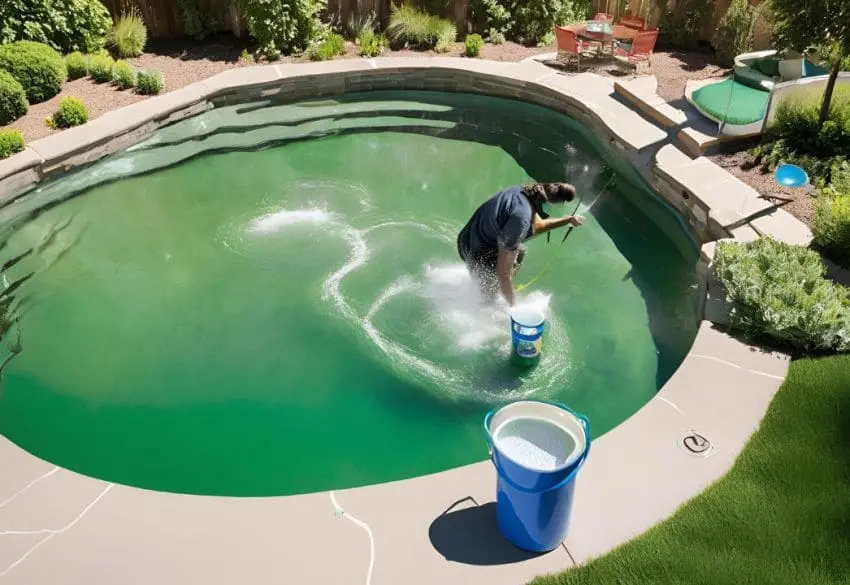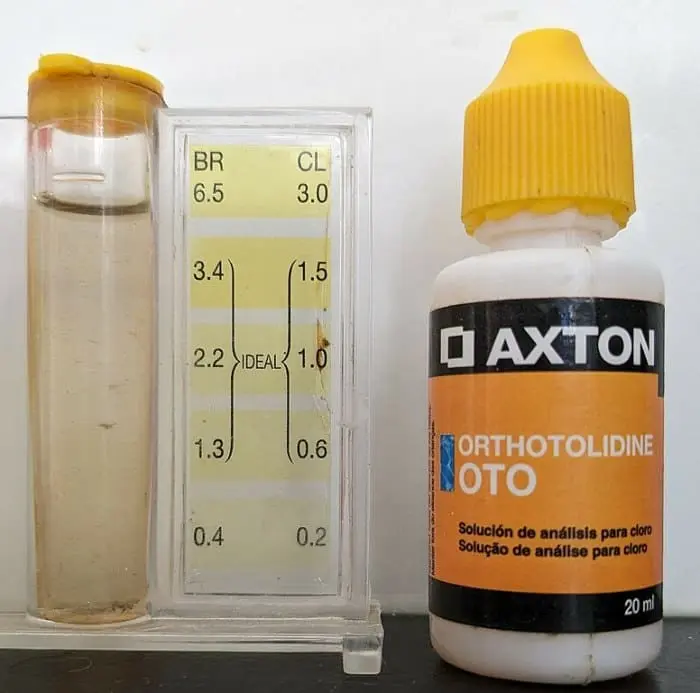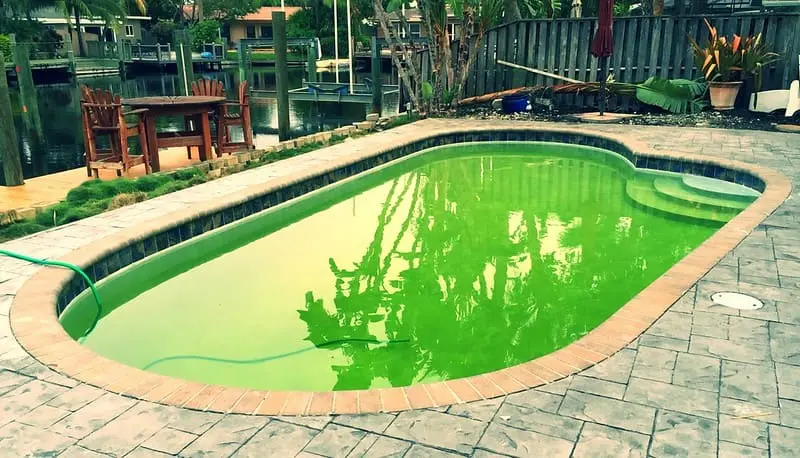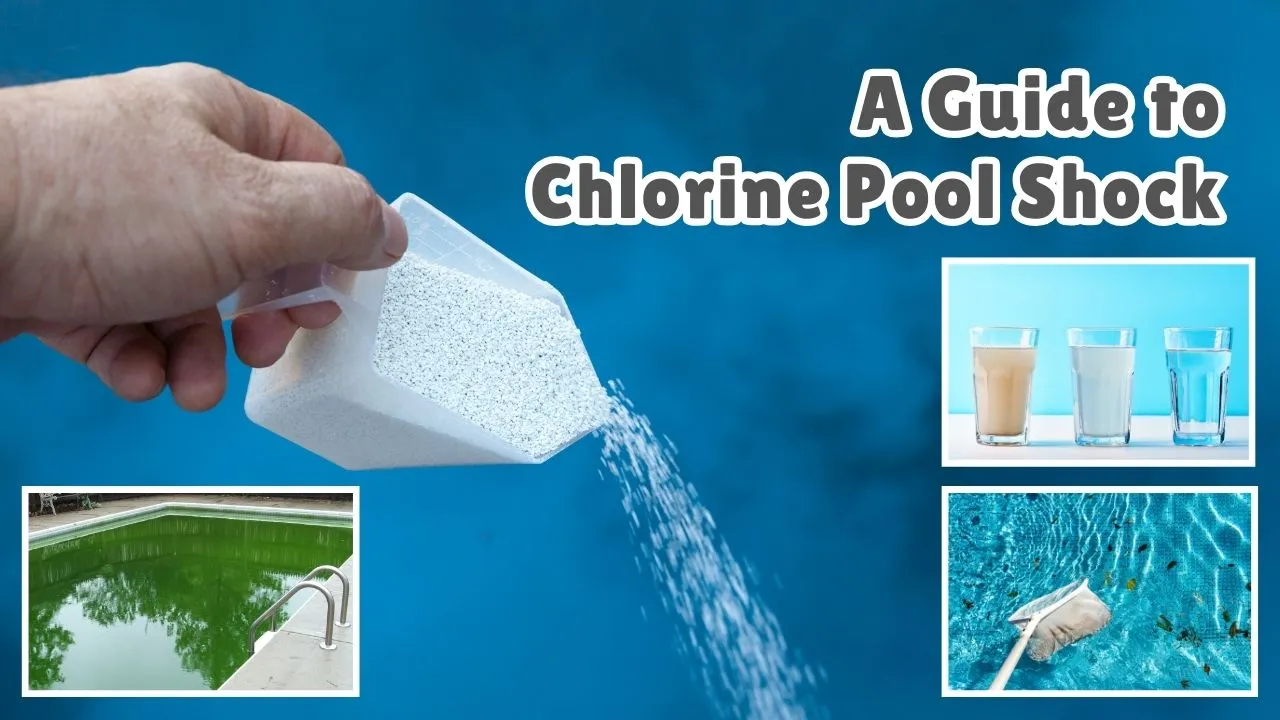Pool Shock: It is a process of adding chlorine based chemicals that raises the chlorine level within the pool water which kills any bacteria, algae, contaminants, chloramines, mosquito eggs and larvae, etc. This can be done using liquid chlorine or chlorine in powdered or granulated form.
If you have got a pool than you must be knowing the hard work needed to clean and maintain the pool. Not only just cleaning the fallen leaves, algal growth, contamination and other debris, but also preventing any breeding of mosquitoes in pool water.
The pool water becomes green, filthy, and looks dirty with a foul smell. Cleaning can be done with water filtration systems, skimmers, manual nets but for algae and bacterial growth, mosquito eggs and larvae, chloramines; you need to learn how to do a pool shock with a chlorine pool shock treatment.
Commercial pool shock products are more than just chlorine. They are made of concentrated blend of chemicals which effectively oxidizes the contaminants, sanitize the bacterial and microbial growth, breakdown chloramines that have build up due to reaction of chlorine with sweat, oil and other organic matters present in pool water.
Table of Contents
Reasons, why you need to shock your pool
Regular pool water chlorination is not enough as the contaminants in pool water like organic matters, skin lotions, makeup, sweat, body oils, as well as urine, reacts with chlorine and forms chloramines and thus the effective chlorine levels goes down. These chloramines makes the pool water cloudy with a foul smell.
Regular chlorine pool shock treatments are very important for your pool because of following reasons:
- There are impurities and contaminants like chloramines a byproduct formed by the reaction between contaminants, impurities and free chlorine.
- Pool water may also contain pathogens and mosquito larvae, as pool water is the most ideal breeding site for mosquitoes.
- The pool water may turn green due to algae growth
- Chlorinating or restoring the pH and chlorine levels of your pool to keep it effective against microbes and pathogens and ensuring its effectiveness in continuing sanitizing your pool
What is “Chlorine pool shock”?
Chlorine Pool Shock refers to the process of adding a high dose of chlorine, sometimes along with other chemicals to the pool water and temporarily hold it for certain period of time. After which the chlorine levels are brought back to normal. During this holding period, the pool water experiences a high level of chlorine around 10 to 30 ppm which destroys the algae, bacteria, organic matter, chloramines, etc.
This chlorine pool shock treatment is necessary to kill any pathogens that might be breeding in the pool water and also to prevent any water borne diseases.
There are various commercial products available for pool shock which includes granular chlorine, liquid chlorine also called as liquid pool shock, and also non-chlorine pool shock products. The most common product for swimming pool shock is calcium hypochlorite.

Types of Chlorine pool shock treatments
1. Calcium Hypochlorite (Cal Hypo)
Calcium hypochlorite pool shock or Cal Hypo is the most popular and commonly used chlorine pool shock that comes in granular form. It contains available free chlorine around 65 to 70% and very effectively kills bacteria and algae. However, it increases the calcium hardness in pool water that is responsible for forming scales on pool walls. It also requires pre-dissolution as direct addition of granular chlorine will damage the pool surfaces.
2. Sodium Hypochlorite (Liquid Pool Shock)
Liquid pool shock or liquid chlorine is available in liquid form and it contains 10 to 12% available chlorine, therefore no pre-dissolution is required. Liquid chlorine also has a near neutral pH and therefore the pH of the pool does not change considerably. Since milder in concentration will need to add more of it.
3. Dichlor
Sodium dichlor contains 56% of available chlorine and is stabilized with cyanuric acid for making it stable to be used in outdoor pools to protect the chlorine from oxidation in presence of strong sunlight with UV rays. Any overuse of cyanuric acid will result into acid build up in the pool, which will reduce the chlorine effectiveness.
4. Lithium Hypochlorite
Lithium hypochlorite is also milder in concentration and contains 35% available chlorine. It is also granular in form but dissolves quickly in water and does not lead to formation of scales. It also doesn’t increase the calcium hardness but is more expensive than Cal Hypo and therefore rarely used.
5. Non Chlorine Shock
Non chlorine pool shock is a made of special oxidizing chemical, mainly potassium peroxymonosulfate that does not contain chlorine. It does not alter the chlorine levels in the pool water and effectively oxidizes pool contaminants and clears the cloudy water. This type of pool shock treatment is needed where pool water already contains high chlorine levels but needs a thorough cleaning.
It does not kill bacteria and algae and therefore it cannot be replaced with chlorine pool shock treatments. However, we can practice it after a proper chlorine pool shock treatment.
Does pool shock kill mosquito larvae?
Yes, pool shock kills the mosquito eggs and larvae as it creates a strong chlorine environment which alters the water chemistry and damages their cellular structure. Thus, proper pool shock treatment will effectively kill the mosquito larvae breeding in standing water in a pool.
This chlorine attacks the larvae and disrupts their development and growth process. The chemical balance during the pool shock treatment is of great significance while targeting mosquito larvae. A slight negligence in maintaining your pool even when not in use, will become a mosquito breeding haven.
How to shock your pool?
As discussed above the types of pool shock treatments, we will explain the most common and widely used pool shock treatment which involves use of liquid chlorine or chlorine granules (Cal hypo). The complete method to shock a pool is given below with steps.
How to shock a pool with liquid chlorine pool shock treatment?
Its a 24 to 36hrs long process and should be done in sequential steps one after another. A step-by-step guide on “How to do liquid chlorine pool shock treatment?”, is as follows:
Step #1: Test the pool water
Always test your pool water for a few parameters with a reliable test kit, before heading for a pool shock treatment. Check the following parameters before a pool shock:
- Chlorine levels (should be between 1 and 3 ppm)
- pH level (should be between 7.2 to 7.6)
- Total alkalinity (should be between 80 to 120 ppm)
- Calcium hardness (should be between 200 to 400 ppm)
Note: The pH of the pool water should be maintained between 7.2 to 7.6 to get the maximum effectiveness of chlorine in subsequent chlorine pool shock.

Image Credit: Wikimedia by Registreernu | Content License
Step #2: Select a suitable pool shock product
Based on the quality of water, your usage and frequency of pool shock, you need select a right chlorine pool shock product. For general regular maintenance liquid chlorine pool shock is recommended. While if you want to deal with bacteria and algae growth than go with the stronger chlorine pool shock product like Cal Hypo.
Step #3: Calculate the amount of pool shock to be added
We need to add sufficient pool shock to raise the chlorine levels to at least 10 to 30 ppm. The exact amount of pool shock needed for a chlorine pool shock treatment, that you can calculate using a simple mathematical expression given in this article – How to Use Chlorine or Bleach to Kill Mosquito Larvae in pool water?.
How much liquid chlorine to shock pool? For a general idea or as a thumb rule, you can use the following amount of pool shock but its again depend on the quality of water and chlorine levels before the pool shock:
- Calcium Hypochlorite (65 to 70 % available chlorine): 1 pound of Cal Hypo for every 10,000 gallons of pool water to raise chlorine levels by 10 ppm. If you need to give a pool shock with 30ppm of chlorine, than you need to use 3pounds of Cal Hypo every 10,000 gallons of pool water.
- Liquid pool shock (12% available chlorine): Use 1 gallon of liquid pool shock for every 10,000 gallons of pool water.
Note: Check product label for manufacturer’s instructions and dosage recommendations
Step #4: Pre-dissolution of granular shock
If you are using granular pool shock than you may need to dissolve it first in a bucket to prevent bleaching or any damage to pool liners. While dissolving, always add the pool shock (Cal hypo or dichlor) in a bucket of water and not adding water on the granular calcium hypochlorite. Make sure the granules are completely dissolved before adding it to the pool water.
Step #5: Add the pool shock to the pool water
Avoid using pool shock in day light. Preferably pool shock should be done late evening to avoid decomposition of chlorine due to UV radiation. Add the chlorine pool shock solution evenly around the perimeter of the swimming pool and make sure the pump is running to circulate the pool shock throughout the water.
Step #6: Brush and pool walls and floor and run the pump
Use a brush and scrub the pool walls and floor to clear the algae, slime and calcium deposits. Run the pump and collect the debris through a skimmer and underground filtration system. Keep the pump running for further 10 to 12hrs to clean the water.
Step #7: Re-test the pool shock treated water
Now re-test the chlorine levels in the pool water after 24hrs. It should have dropped to below 3 to 4 ppm. If it is still high keep the pool open and allow it to drop naturally through direct sunlight and aeration which will degrade chlorine and bring it down to the required levels. Once the chlorine levels are dropped to around 1 to 3 ppm, than only allow swimmers to enter the pool.
How to shock a pool that is green?
If your pool is green it indicates heavy algae growth that may also contain bacteria and disease causing pathogens and microbes. Since it is a stagnant source of water, it may also contain mosquito eggs and larvae. This condition of pool usually happened due to negligence and poor maintenance of pool water. Shocking the pool and using clarifiers are the most necessary steps you need to follow in such a situation.
While all other steps will remain the same as given above, and the chlorine levels for pool shock should be maintained on a higher side up to 30 ppm for clearing the algae and other contaminants.

Image Credit: Flickr by sdobie | Content License
Maintaining proper chlorine levels after pool shock treatment
After completing the pool shock treatment, and bringing back to normal chlorine levels, it is important to maintain the pool water with adequate chlorine levels to avoid any chances of algae or bacterial growth, mosquito infestation, etc. Regular testing and monitoring the pH and chlorine levels is required.
Adjusting with minor additions on a daily basis to maintain the required adequate levels will help you to keep your pool water clean and free of algae, pathogens, contaminants, mosquito eggs and larvae, etc.
Depending on your use you should shock your pool every week or fortnight to maintain the free chlorine levels between 1 to 3 ppm.
How long after putting shock in pool can I add clarifier?
Clarifiers are coagulating agents that are added to precipitate impurities and promote settling of dirt and small particles in order to clarify the cloudiness in pool water. This can be removed later using filters and skimmers. This clarifier however should not be added immediately after shocking the pool.
The addition of clarifiers along with the pool shock may alter the effectiveness of chlorine or catalyze the decomposition of chlorine. Therefore, you should wait for at least 24 to 36hrs before adding clarifier. This waiting period will complete the pool shock process and will allow the chlorine levels to return back to normal.
Once the chlorine levels are back to near normal, you can add clarifier and make sure the filtration is running to remove all the cloudiness and settled impurities after the shock treatment.
When and how often you should shock your pool with liquid chlorine?
It is important to know how often you need to shock your pool to keep it healthy and clean. There are few indicators that you need to observe regularly based on which you need to shock your pool, and will calculate accordingly for how much shock to add to pool:
- After heavy use or high number of swimmers or bathers: After you have a lot of guests or swimmers/bathers may be guests or after a pool party, you should shock your pool.
- After heavy rainfall: Strong winds along with heavy rain can bring a lot of dirt, pollutants, debris and contaminants to your pool. This also dilutes the chlorine levels in pool water to some extent.
- Signs of algae blooms: If you see any sign of algae growth like green tint or slime on the walls or floor of the pool you should give a pool shock to your swimming pool.
- Cloudy water: Due to continuous buildup of impurities and contaminants mainly due to insufficient chlorination your pool water may look cloudy. Swimming pool shock treatment will make your water clear.
- Strong chlorine odor: Any excess buildup of chloramines will give a foul odor with a strong chlorine smell which is not of the free chlorine. A pool shock is needed to eliminate these chloramines from your pool water.
- Weekly or as per scheduled maintenance: The ideal water conditions of your pool should be set according to your usage and chlorine pool shock requirements, and based on that create scheduled maintenance every week, every 10 days or fortnightly.
What is the difference between pool shock and chlorine?
| Pool Shock Treatment | Pool water Chlorination |
|---|---|
| (i) In pool shock treatment, we are adding sufficiently higher dose of chlorine to maintain the chlorine levels around 10 to 30 ppm, | (i) chlorination we are maintaining the chlorine levels to sufficiently lower side around 1 to 3 ppm. |
| (ii) During pool shock treatment, we cannot use swimming pool due to excessively higher concentrations of chlorine. | (ii) While chlorination is done to keep the swimming pool safe and secure for swimmers and giving a continuous sanitizing effect in water. |
| (iii) During pool shock treatment, the chlorine levels are raised high enough and after 24hrs brought back to normal range. | (iii) The chlorine levels are required to maintain throughout and does not allowed to drop. |
| (iv) Pool shock is mainly done to clear the debris, contaminants, algal growth and chloramines, to make the water clear. | (iv) Chlorinating the pool water is necessary to keep the pool water sanitized and prevent any algae and microbial growth. |
How long to wait to add chlorine after shock?
During pool shock the free chlorine added in form of calcium hypochlorite or liquid chlorine or bleach, is get consumed in oxidizing the impurities and contaminants. The consumption of this chlorine depends on the impurities and contaminants in your pool water.
If it is clean enough without much cloudiness, algae, bacteria and chloramines, than unused chlorine will remain in the pool after a pool shock. Once this chlorine levels are back to normal around 1 to 3 ppm you o not allow any swimmers or bathers to enter the pool.
After the pool shock, and once the chlorine levels are dropped down to the required levels the chlorine will get used up by performing its sanitizing role by reacting with the body oils, makeup, sweat, urine etc. And if there are not much swimmers and the pool size is quiet big than you may not need to add chlorine any soon.
You can test and check the drop in chlorine levels and than decide upon the pool shock and maintenance schedule accordingly depending on your usage and chlorine levels.
How to shock above ground pool?
The pool shock process is same whether the swimming pool is above the ground or in-ground, there is no difference at all. In both the cases, you need to make sure of the following:
- The pH of the pool water should be between 7.2 to 7.6
- The pool shock should be properly dissolved by adding the granules or powder to the water and not the other way.
- Add the dissolved solution evenly on all sides and corners of the pool.
- Make sure pump is running till pool shock is evenly distributed.
- Remove any debris, fallen leaves, algae blooms, calcium scales, etc. by rubbing with a scrub and removing with a skimmer.
- Allow 24hrs for chlorine to perform.
- Retest for chlorine levels and do not allow swimmers unless and until the chlorine levels are below 3 to 4 ppm.
📰 Must Read,
✔️ Home Remedies to Get Rid of Mosquito Bites Overnight
✔️ What Plants Attract Mosquitoes
Conclusion
Carrying out weekly maintenance of your swimming pool with a scheduled pool shock treatment is very important to prevent nay mosquito breeding and algae and microbial growth and also any water borne diseases. The pool shock is necessary to keep the swimming pool water clean, clear and safe.
Following proper measures and instructions and process steps, including the selection of right pool shock product, are important as it depends on what kind of pool water you are going to shock.
Calculating the required amount of chlorine granules or liquid chlorine is the trickiest step. Regular shocking and pre-planned maintenance are necessary for keeping your pool in optimum conditions during seasons.
Frequently Asked Questions (FAQs)
-
How to shock a pool with liquid chlorine?
The method remains the same, you have to calculate first the amount of liquid chlorine require to shock your pool. Roughly around 1 gallon of liquid chlorine (12%) is added to 10,000 gallons of pool water. Add the required amount in the pool and keep the pump on for circulation. Hold for 24 hrs and bring back the chlorine levels back to normal.
-
How to shock a pool with granular chlorine?
For granular chlorine, you need to dissolve it first in bucket of water. You will be needing smaller amount as its concentrated and contains around 65 to 70% of available chlorine. After dissolving add the solution in all corners of the pool. Put on the pump to get the solution mixed evenly throughout the pool water.
-
Why my pool shows no chlorine after shock?
Excess buildup of algae, bacteria and phosphates in your pool may deplete your added chlorine levels. These huge amount of chlorine consuming impurities and contaminants in the pool will accelerate the rate of chlorine demand and thus you will get no chorine after shock in testing kits.
-
How long after adding algaecide can you shock?
Algaecide is used to prevent generation of algae blooms or like preventing any algae growth in future. But pool shock is done to clean the algae which is present already. When algaecide is added along with pool shock it will interfere the effectiveness of the pool shock treatment. You should wait for at least 24hrs for adding algaecide after adding pool shock.
-
Can I add chlorine after algaecide?
After adding a pool shock you need to clean off all the floating as well as settled impurities and sludge through filters and skimmers. Than you have to wait for 24hrs before adding algaecide, this will prevent algal growth in future. After this you need to check the chlorine levels if it is below the required levels of 1 to 3 ppm than you must add chlorine.
-
Is pool shock the same as chlorine?
NO, pool shock is different where we use higher concentrations of chlorine, around 10 to 30 ppm, while in chlorinating pool water we use lower concentrations of about 1 to 3 ppm of available chlorine.
-
How much pool shock to use?
The amount of pool shock can be calculated as per the form of chlorine that you are using. For granular Cal Hypo (65% approx., available chlorine) you can use 1 pound of Cal Hypo in 10,000 gallons of water. And if you are using Liquid chlorine (12% approx., available chlorine) than you can add 1 gallon of liquid chlorine in 10,000 gallons of water.
-
How long does it take to shock a pool?
It takes almost 24 to 36hrs for shocking a pool. For cleaner pools which are well maintained with regular pool shock schedules, it will be done much sooner as like 12 to 18 hrs. It also depends on the actual concentration of the pool shock as they contains chlorine compounds that are unstable and decomposes when stored in hot and warm areas exposed to light.
-
How much shock for 1000 gallon pool?
For pool shock you need to raise your pool’s chlorine levels to around 10 to 30 ppm which depends on the severity, dirt, contamination and presence of algae, bacteria, mosquito larvae, chloramines, phosphates, acidic products, etc. For almost clean and maintained pool water, you can raise chlorine levels to just around 10 ppm for a normal regular pool shock.
1000gms of Calcium Hypochlorite ==> has 650gpl of chlorine,
Xgms of Calcium Hypochlorite ==> will have 0.01gpl of chlorine
X = 0.01 x 1000 / 650 = 0.015385 gms
0.015385 gms of Calcium Hypochlorite (65%) will give 10ppm of chlorine in 1 litre of water.
…it means for each litre of pool water, you have to add 0.015385 gms of Calcium Hypochlorite (65%)And, for 1000 gallons which comes around 3785.41 litres (1000 X 3.78541), you will need,
3785.41 X 0.015385 =58.239 gms of Calcium HypochloriteAnd, for a swimming pool with a volume of around 15,000 gallons of water, you will need:
15000 X 3.78541 X 0.015385
= 873.58gms of Calcium Hypochlorite (65%)*Note: Please make sure to check and refer the product label and dosage recommendations before using any pool shock products and also the actual concentration as these are unstable chemicals. Also check for chlorine levels before allowing swimmers and bathers back to the pool.
-
How often should I shock my pool?
You should check the condition of the pool and implement regular cleaning and filtration. Check for any signs of algae, bacterial growth or any mosquito infestation, cloudiness, haziness, green coloration, etc. This indicates heavy load of algae, chloramines and may be calcium deposition which should be taken care by pool shock every 10 to 15 days.
-
Why is my pool still green after chlorine pool shock treatment?
The chlorine levels has been depleted soon or your pool shock or Cal Hypo is lesser than the mentioned concentration, or you might have done wrong calculation for Cal Hypo requirement. The levels of chlorine also depends on the total alkalinity, pH, CYA and chloramines still present in water.

